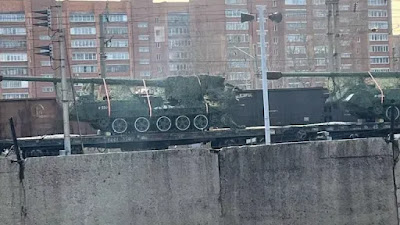Filenews 19 November 2024 - by David Axe
Some of North Korea's largest artillery systems were seen crossing Russia by train. It could be a sign that Pyongyang is not only supporting Russia with thousands of troops — it is also sending artillery.
On Thursday, a photo circulated on social media showing two M1989 Koksan 170mm artillery systems being transported by train to Krasnoyarsk, Siberia.
There are two possible scenarios: first, that a North Korean artillery unit is deployed on the front line in western Russia or Ukraine. Second, that a Russian unit will operate tracked machine guns, with a crew of 4 people, which can fire projectiles weighing 100 kg or more at a distance of 40 kilometers.
The second makes more sense. So far, the Kremlin is sending North Korean troops to existing Russian units. The first thousands of North Koreans transported by truck to the front line in the Kursk region last month joined Russia's 810th Marine Brigade.
These North Koreans have not yet appeared on the "line of contact" of the two opposing camps, but they are expected to enter the battle. For months, the Russian army has been losing 1,500-2,000 soldiers a day (dead and wounded). A rate of casualties that even the Kremlin, with its hefty fees for enlisting in the Russian army, cannot match.
Russia needs external assistance in both troops and equipment to continue the war in Ukraine next year. Now the Kremlin's stockpile of weapons from the Cold War era is dangerously depleted.
Stocks of artillery systems are declining just as quickly as stocks of tanks and combat vehicles. A search of Russian military depots in early 2024 recorded 3,000 self-propelled artillery systems, up from 4,500 in 2021. It is likely that many of these 3,000 systems have been worn, corroded or damaged and are not functional.
Some of the 1,500 self-propelled artillery systems the Russians took out of their warehouses years later, in 2022 and 2023, replaced the roughly 800 SPH lost by the Russians in Ukraine. Others are equipping new units that the Kremlin has set up since the war began. And some are being cleared for their parts, especially the barrels of their machine guns, as Russian industry struggles to produce new ones.
Russian artillery would catch its breath by picking up a few batches of North Korean M1989s. It looks like the largest tracked artillery system the Russians have: the 2S7. In 2022, Moscow had about 300 2S7 artillery pieces – about 10% of them have been neutralized or captured by the Ukrainians, while many of those that have been in storage for decades have been put into disuse.
The problem for the Russians is ammunition. The M1989 is the only 170mm artillery system widely used – and only North Korean industry produces ammunition for it. Moscow has been buying missiles from Pyongyang since the beginning of the war in Ukraine, but for more calibers the munitions are produced domestically.
This cannot be done for the M1989 and its "special" ammunition. These huge weapons will or will not enter the battle, depending on Pyongyang's mood. "The Russian army has always had weaknesses in its logistical infrastructure. North Korean artillery systems may at some point make up for the shortage of ammunition," observed Artur Rehi, an Estonian soldier and analyst.
Further evidence that Russia is increasingly dependent on its allies — North Korea and Iran — to support its war effort in Ukraine.
